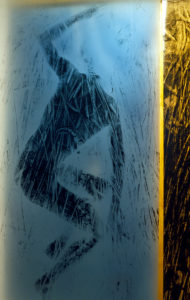Commissioned by The Walsall Art Gallery 1994.
Shown at Leeds Metropolitan Gallery in 1995.
Hung into the space are three sets of triptychs; photographic life-size images of a male and female in tall rye grass. (Holland grew the rye grass and it was left to reach its maximum height before being harvested) Behind these are encaustic (coloured and melted beeswax) panels, which add both colour to the panels and odor; the heat from the back lighting conducts the smell of hot beeswax and honey. There were also three sets of triptychs presented on light boxes which contained Ilfochrome transparencies; one set of figures, one of frogs and one of snakes.
The theme of growth and subsequent cutting or harvesting is explored again here. The title is taken from a line in Milton’s ‘Comus’. This allegorical tale can be read as a satire on the evils of church and state, the poet’s lesson against sin and impurity and the education of the soul. The photographic images reflect the ‘wilderness’ of the poem. These enclosed ritualistic scenes are viewed from the earth’s base upwards. The tall flanking rye grass is an almost liquid medium in which the figures and creatures emerge and hide. The cut golden hair, the rye and its seed reference a harvest; part of a natural cyclical occurrence. There’s also a more human ‘yield’ referred to here, the fateful reaping of results that grow from our actions; good and bad.
View images from the Installation at Walsall City Art Gallery and Leeds Met









